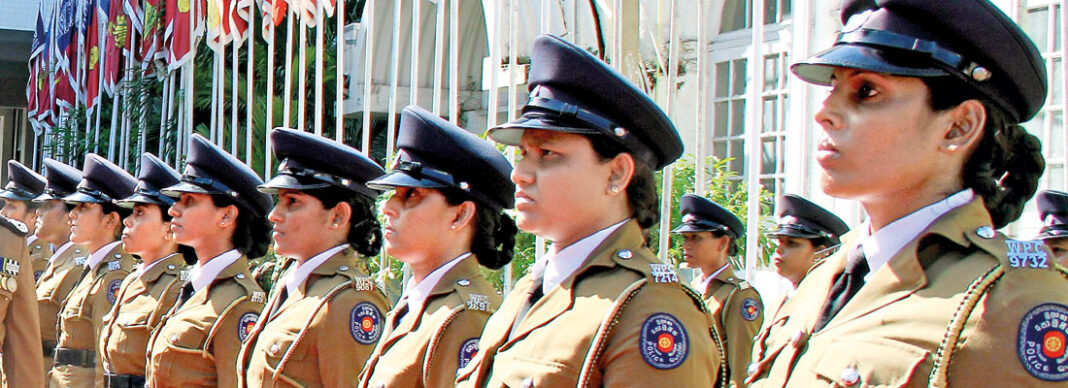For, eighteen years after it was approved, the Police Department is yet to implement a 2006 Cabinet decision that 15% of all levels in the police force, from top to bottom, be allocated to women.
As recently as 2016, a mere eight years ago, there was only one approved cadre position for a female SSP. There were no cadre positions for female Deputy Inspectors General of Police (DIGs) and Senior DIGs. There were just two slots for female Superintendents of Police (SP) and 15 for female Assistant Superintendents of Police (ASPs).
But a group of policewomen who were rising through the ranks decided they deserved career progression. So they organised themselves and furiously lobbied the Police Department, the Finance Ministry’s Management Services Department, the National Police Commission (NPC), the Human Rights Commission of Sri Lanka (HRCSL) and others. At times, they waited for hours outside the offices of their police higher-ups, seeking redress.
Some policewomen (who were ASPs at the time) even petitioned the Supreme Court against gender bias in the Police Department. They requested Court to declare inter alia that women officers in the police service were entitled to the same promotions as male officers in the same cadre without discrimination. The case has been dragging on since 2016.
In 2019, through the NPC’s intervention, the single cadre position set aside for women SSPs was increased to 13. Had this not been done, SSP Muthumala would not be Director CID today. And there would be no women DIGs.
Other slots were also created. Today, there continues to be only one vacancy for an SDIG, created in 2021. But there are four slots for female DIGs—all of which are currently held by Acting WDIGs who will face an interview board in January for promotion to full DIG—and 13 for female SSPs. There are also just four positions for female Superintendents of Police (SPs).
Pillar to post
This still means that persevering and dedicated policewomen are increasingly becoming eligible for promotions they won’t ever receive. At present, there are around 10,000 females in the police force. And given the spike in offences against women and children, and a rise in duties that necessitate the involvement of policewomen, recruitment must increase.
In May this year, policewomen across the ranks presented their grievances verbally and in writing to the NPC. Among other things, their report stressed the need for the 15% quota to be introduced from Woman Police Constable (WPC) upwards, as passed by Cabinet.
The report pointed out that Sri Lanka has pledged in its National Action Plan (NAP) for the Implementation of the UN Security Council’s Resolution on Women, Peace and Security 2023–2027 to “ensure that there is gender parity in recruitments and promotions of the tri-forces and police”. One of the indicators is the number of men and women promoted to higher ranks on a yearly basis.
The policewomen also told the NPC that no female ASPs were recruited directly to the Department since 2008 (SSP Muthumala was a direct ASP recruitment in 2007). The totality of the women’s cadre was simply not proportionately supplemented. Consequently, many female officers—including Inspectors, Chief Inspectors and Sub-Inspectors—with requisite qualifications, including stipulated service period, cannot get promotions. And a lack sufficient female representation means there aren’t enough policewomen to perform essential services.
NPC Chairman Lalith Ekanayake told the Sunday Times the Commission had written to the IGP with these inputs and asked for a response. “Up to now, we have not got any answer,” he said.
No to amalgamation
Meanwhile, the Management Services Department has reportedly expressed its agreement to the 2006 Cabinet proposal in writing while the HRCSL vowed earlier this year to intervene on behalf of policewomen. But any change requires policy decisions within the Police Department—and they seem to be leaning towards amalgamation which female officers predict will worsen their predicament.
Women won’t know “where we rank in terms of seniority and other qualifications amidst all these men” if the plan goes ahead. The competition will be tenfold more for the combined DIG cadre, however eligible women might be. And given the high prevalence of men of relevant experience and age, there might never be a female SDIG; certainly not a female IGP, which women were slowly but determinedly carving a path towards.
It was also pointed out that the Police Department’s male hierarchy are only now calling for the cadre to be combined—after women finally won some senior slots for themselves. “When policewomen had no cadre positions, they didn’t want to combine the two,” one observer said. “Now that policewomen have some cadre positions, they want to amalgamate. If this happens, they will end up giving the vacancies to men.”
Still waiting for implementation of a 2006 Cabinet decision
Women police have long been pushing for the implementation of a 2006 Cabinet decision to allocate 15% of positions at every rank to females. If this is applied, the number of Women SDIG positions will rise from one to two. DIG will increase from four to seven while SSP go up from 13 to 25. SP positions will increase from four to 24 and ASP from 16 to 47.
As for men, there are positions at present for 14 male SDIGs, 46 male DIGs, 159 male SSPs, 162 male SPs and 314 male ASPs.
If avenues are not created for senior policewomen to receive deserved promotions and fulfill legitimate aspirations, and if other women are not promoted throughout the ranks, there is a real risk that there will be no more women to take over some of the top positions in the police force in the near future.
Excerpts from “Hard won battles may soon be lost for policewomen” published in the Sunday Times
